Assessment and Severity Of Burns
The severity of a burn is estimated based on its depth and size. Doctors use methods like the Rule of Nines to assess the percentage of the body affected.
Burn Depth Categories
- Superficial (First-degree) – Red, painful, affects only the outer skin.
- Partial-thickness (Second-degree) – Blisters, swelling, deeper skin layers affected.
- Full-thickness (Third-degree) – White, leathery, painless due to nerve damage.
- Fourth-degree – Extends to muscles or bones, life-threatening.
Estimating Burn Size
- Rule of Nines – Divides the body into sections of 9% or 18% to estimate the affected area.
- Palmar Method – The patient’s palm represents 1% of their body surface.
Call 999 for emergency help if the burn appears severe or the casualty is struggling to breathe due to smoke inhalation.
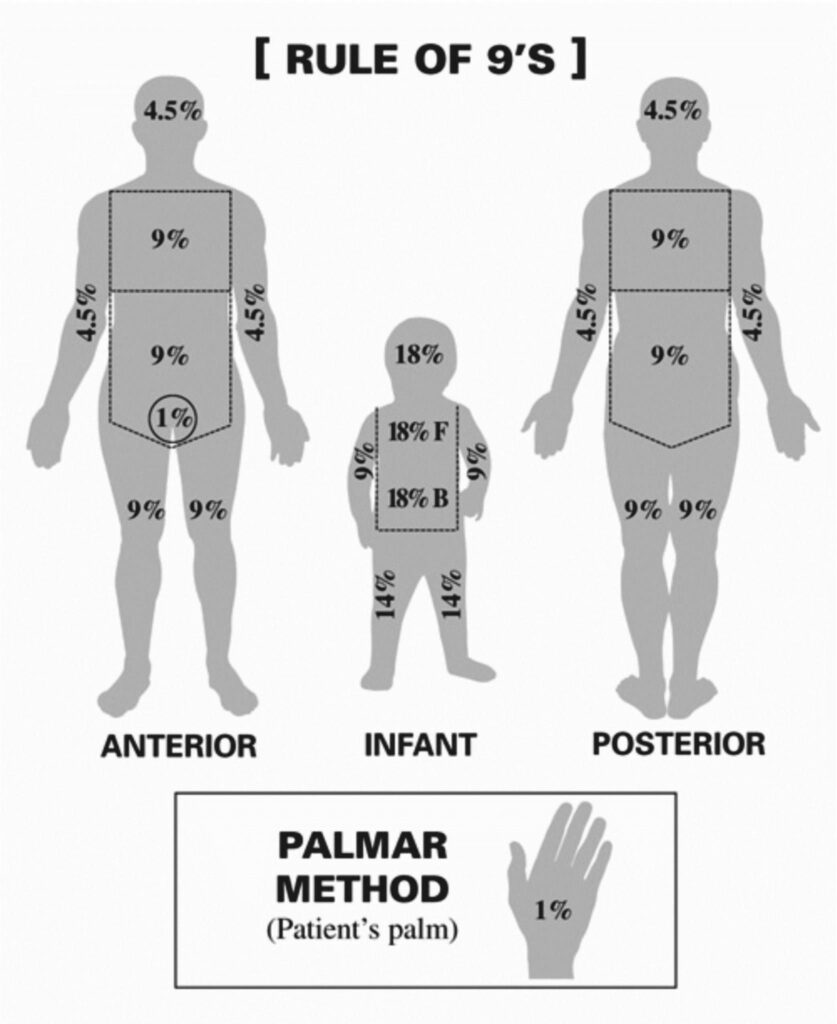
Size Cause Age Location Depth
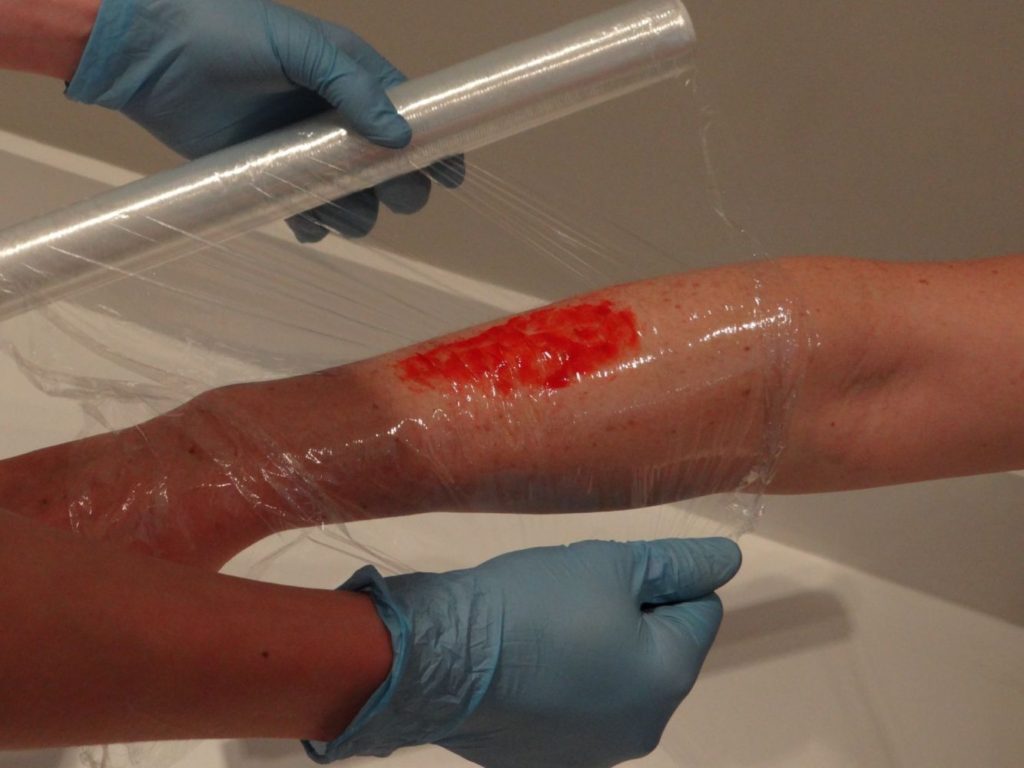
Several factors, including location, inhalation injury, and patient age, influence the severity of a burn injury.
1. Location of the Burn
- Burns on critical areas like the face, hands, feet, joints, and genitals require specialised care.
- Circumferential burns (wrapping around a limb or torso) can restrict circulation and breathing.
- Burns on the airway or lungs due to inhalation of hot gases or smoke can be life-threatening.
2. Inhalation Injury
- Occurs when heat, smoke, or toxic gases damage the respiratory system.
- Symptoms include coughing, shortness of breath, wheezing, and soot in the mouth or nose.
- Can lead to carbon monoxide poisoning or acute respiratory distress syndrome (ARDS).
- Requires oxygen therapy, bronchodilators, and sometimes mechanical ventilation for treatment. You can read more about inhalation injuries here.
3. Patient Age
Older adults may have pre-existing conditions that complicate recovery.
Infants and elderly individuals are more vulnerable due to thinner skin and weaker immune responses.
Children have a higher risk of dehydration and shock from burns.
Types Of Burns
Wet heat burn
Also known as a scald, it is caused by hot liquids or steam rather than dry heat sources like fire or hot surfaces. Scalds can be just as severe as traditional burns and require immediate care.
Common Causes of Scalds
- Boiling water or hot beverages
- Steam from cooking or industrial equipment
- Hot oil or grease
- Hot bath water
Symptoms
- Red or peeling skin
- Blisters
- Swelling
- Pain or tenderness
First Aid Treatment
Seek medical attention – If the burn is large, deep, or affects sensitive areas like the face, hands, or joints.
Cool the burn – Run lukewarm or cool water over the affected area for 20-30 minutes. Avoid ice or very cold water.
Remove clothing or jewellery – If not stuck to the skin.
Cover the burn – Use cling film or a clean plastic bag to protect the area.
Pain relief – Take paracetamol or ibuprofen if needed.
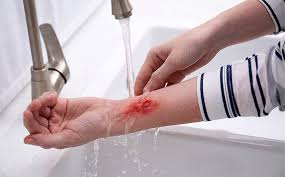
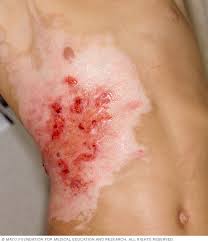
Chemical burn
Occurs when the skin, eyes, or internal organs come into contact with a corrosive substance, such as strong acids or bases. These burns can range from mild irritation to severe tissue damage.
Common Causes
- Household cleaners (bleach, drain cleaners)
- Industrial chemicals (sulfuric acid, ammonia)
- Battery acid
- Tooth-whitening products
- Pool chlorinators
Symptoms
- Redness, irritation, or burning
- Pain or numbness
- Blisters or blackened skin
- Swelling
- Difficulty breathing (if inhaled)
First Aid Treatment
Seek medical help – Call 999 if the burn is severe or affects sensitive areas.
Remove contaminated clothing – Carefully take off anything with the chemical on it.
Flush with water – Rinse the affected area with cool running water for at least 20 minutes.
Avoid neutralising agents – Do not apply creams or other chemicals.
Radiation burn
Occurs when the skin or tissues are damaged by exposure to radiation. This can happen due to radiation therapy for cancer, prolonged exposure to UV rays, or high doses of ionising radiation.
Symptoms
- Redness or darkening of the skin (depending on skin tone)
- Itchy, dry, or peeling skin
- Swelling or blistering
- Open sores in moist areas (like armpits or under breasts)
- Pain or tenderness
Causes
- Radiation therapy is common in cancer treatment.
- Sunburn – most common, caused by excessive UV exposure.
- Industrial radiation exposure – From X-rays, gamma rays, or microwaves.
Treatment & Care
- Moisturising creams – To soothe irritation.
- Avoid harsh soaps – Use gentle, fragrance-free products.
- Cool compresses – To reduce discomfort.
- Medical intervention – Severe cases may require specialised care.
Radiation burns can range from mild to severe, depending on the dose and duration of exposure. If symptoms worsen, consult a healthcare professional.
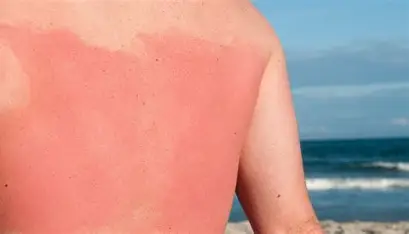
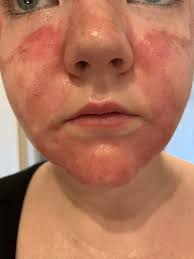
Dry heat burn
Occurs when the skin is damaged by direct contact with fire, hot objects, or friction. Unlike scalds, which are caused by wet heat (like steam or boiling water), dry heat burns result from sources such as flames, heated surfaces, or prolonged sun exposure.
Symptoms
- Redness and swelling
- Blisters or peeling skin
- Pain or tenderness
- White or charred skin in severe cases
First Aid Treatment
Seek medical attention – If the burn is large, deep, or affects sensitive areas like the face, hands, or joints.
Cool the burn – Run lukewarm or cool water over the affected area for 20-30 minutes. Avoid ice or very cold water.
Remove clothing or jewellery – If not stuck to the skin.
Cover the burn – Use cling film or a clean plastic bag to protect the area.
Pain relief – Take paracetamol or ibuprofen if needed.
Smoke inhalation
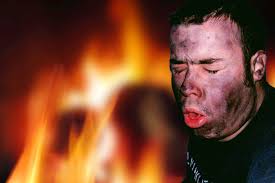
Smoke inhalation occurs when harmful smoke particles and gases enter the lungs, often during fires. It can cause serious respiratory damage and is a leading cause of fire-related deaths.
Causes
- Burning materials release toxic gases like carbon monoxide and cyanide.
- Chemical irritation damages the respiratory tract.
- Oxygen depletion in fires leads to suffocation.
Symptoms
- Coughing (mucus may be clear, grey, or black).
- Shortness of breath and wheezing.
- Headache and dizziness (due to carbon monoxide exposure).
- Soot in the nose or throat.
- Confusion or unconsciousness.
Treatment
- Move to fresh air immediately.
- Administer oxygen therapy if needed.
- Seek medical attention for severe cases.
Smoke inhalation can worsen conditions like asthma and COPD, so early intervention is crucial
Important
When treating a burn, avoid these common mistakes to prevent further damage:
- Do not apply ice or ice water – It can worsen tissue damage and lead to hypothermia.
- Do not break blisters – They protect the wound, and breaking them increases infection risk.
- Do not apply butter, oil, or grease – These trap heat and slow healing.
- Do not use harsh cleansers – Abrasive substances can irritate the skin.
- Do not expose the burn to direct sunlight – This can cause blistering and worsen scarring.
- Do not ignore smoke inhalation symptoms – If coughing or breathing issues occur, seek medical help.
- Do not use adhesive bandages directly on the burn – They can stick to the wound and cause more damage.
- Do not neglect hygiene – Keeping the burn clean reduces infection risk.
